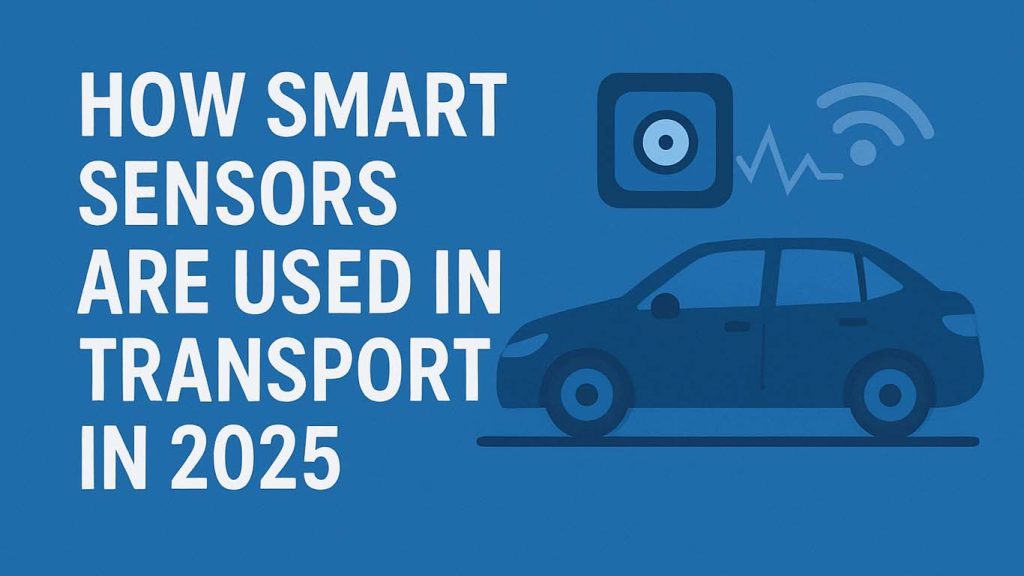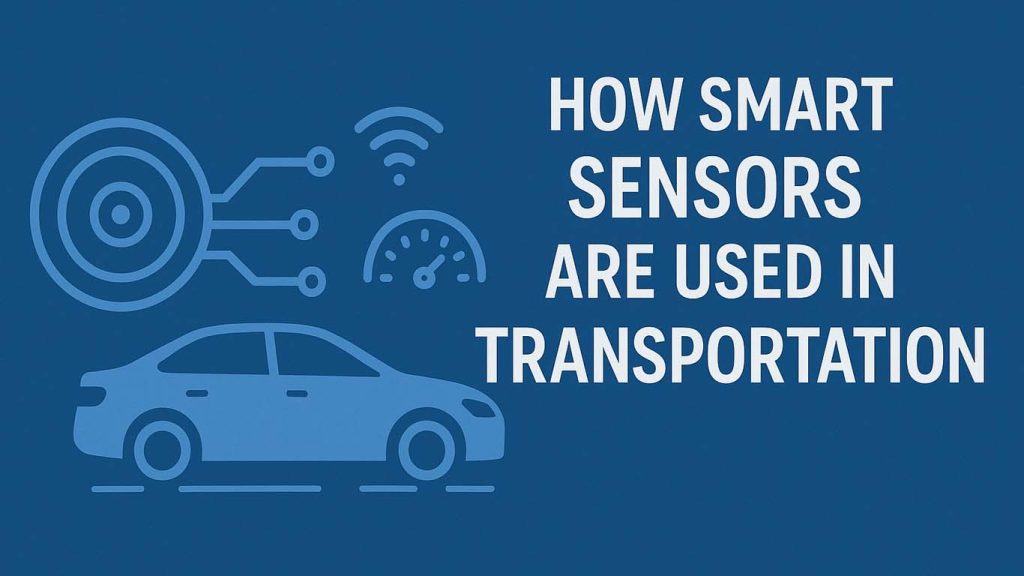
How Smart Sensors Are Used in Transportation
Introduction
Over the past two decades, technology has reshaped every aspect of human life, and transportation stands out as one of the most transformative sectors. The global push toward smarter cities, safer roads, and sustainable mobility has propelled innovations that rely heavily on smart sensors. These tiny, intelligent devices are no longer just passive detectors; they are advanced systems capable of capturing, processing, and transmitting critical data in real time.
From intelligent traffic management to autonomous vehicles and predictive maintenance of railway systems, smart sensors have become indispensable tools in modern transportation. As we enter 2025, their applications are expanding at an unprecedented pace, revolutionizing not only how we move but also how we think about mobility.
This blog post takes a deep dive into how smart sensors are used in transportation, their types, real-world applications, benefits, challenges, and future possibilities.
What Are Smart Sensors?
Smart sensors are advanced sensing devices that go beyond simple data collection. Unlike traditional sensors that only measure and relay information (e.g., temperature, pressure, or motion), smart sensors can:
- Process raw data using embedded microprocessors.
- Communicate wirelessly with other systems.
- Self-calibrate to ensure accuracy.
- Trigger automated responses.
In transportation, these features make smart sensors powerful tools for optimizing safety, efficiency, and sustainability. They can detect everything from road congestion to driver fatigue, then communicate findings to larger networks for immediate action.
Evolution of Smart Sensors in Transportation
The use of sensors in transportation is not new. Early traffic light systems in the 20th century relied on inductive loops buried under roads to detect vehicles. However, the shift toward smart sensors began in the 2000s, with the rise of wireless communication, IoT (Internet of Things), and AI-powered analytics.
By the 2020s, smart sensors became integral to innovations such as:
- Autonomous vehicles: Equipped with LiDAR, radar, and vision sensors.
- Smart traffic management systems: Using cameras, motion sensors, and GPS.
- Public transportation optimization: Monitoring bus occupancy and real-time location.
- Railway safety: Using vibration and acoustic sensors to detect track issues.
Today, nearly every transportation system—road, rail, air, and maritime—integrates smart sensors to deliver safer, smarter, and more connected mobility.
Types of Smart Sensors Used in Transportation
Different transportation challenges require different kinds of smart sensors. Here are the most common types:
- Image Sensors (Cameras)
- Capture high-resolution images or video.
- Used in traffic monitoring, license plate recognition, and autonomous driving.
- LiDAR (Light Detection and Ranging) Sensors
- Provide 3D mapping by using laser pulses.
- Essential for self-driving vehicles.
- Radar Sensors
- Detect objects and measure speed/distance.
- Widely used in adaptive cruise control and collision avoidance.
- Acoustic and Vibration Sensors
- Detect structural issues in bridges, tracks, or vehicles.
- Used for predictive maintenance in railways and aviation.
- GPS and Location Sensors
- Enable real-time navigation and fleet tracking.
- Environmental Sensors
- Measure weather conditions, air quality, and road surface conditions.
- Infrared and Proximity Sensors
- Detect nearby objects for parking assistance and blind spot monitoring.
- Pressure and Load Sensors
- Used in weighing systems for freight transport and monitoring tire pressure.
Applications of Smart Sensors in Transportation
1. Smart Traffic Management
Urban areas face a constant challenge of traffic congestion. Smart sensors are transforming how cities manage vehicle flow:
- Adaptive traffic lights use motion and image sensors to adjust timing based on real-time traffic density.
- Surveillance cameras with AI integration detect violations such as speeding or running red lights.
- Pedestrian sensors improve crosswalk safety by detecting when people are about to cross.
This results in smoother traffic flow, reduced emissions, and enhanced safety.
2. Autonomous and Connected Vehicles
The dream of self-driving cars would be impossible without smart sensors. These vehicles use a combination of LiDAR, radar, and cameras to “see” the environment, identify obstacles, and make driving decisions in milliseconds.
Applications include:
- Lane-keeping and adaptive cruise control.
- Collision detection and automatic emergency braking.
- Vehicle-to-everything (V2X) communication for real-time traffic updates.
By 2025, millions of semi-autonomous vehicles on the road already rely heavily on smart sensors for daily operation.

3. Railway Transportation
Rail systems worldwide use smart sensors for:
- Track monitoring: Vibration sensors detect cracks or misalignments.
- Train positioning: GPS and accelerometers ensure accurate train tracking.
- Passenger safety: Sensors monitor crowd density inside carriages.
For example, Japan’s Shinkansen bullet trains employ smart sensors to monitor seismic activity, enabling trains to stop automatically during earthquakes.
4. Aviation and Airports
Aviation relies on smart sensors for:
- Aircraft health monitoring: Sensors track engine performance and detect anomalies.
- Airport security: Biometric sensors for passenger authentication.
- Runway safety: Weather and surface sensors detect ice or foreign objects.
Airbus and Boeing aircraft now incorporate thousands of smart sensor to improve safety and reduce maintenance costs.
5. Maritime Transportation
Ports and shipping companies integrate smart sensor to:
- Monitor cargo container conditions (temperature, humidity).
- Optimize navigation with GPS and environmental sensors.
- Improve port logistics by tracking vessel positions in real time.
6. Public Transportation Systems
Buses, trams, and metros use smart sensors for:
- Passenger counting and occupancy management.
- Energy efficiency monitoring.
- Real-time arrival predictions for commuters.
These systems enhance reliability and encourage public transport usage.
Benefits of Smart Sensor in Transportation
- Safety
- Prevent accidents with real-time alerts and automated systems.
- Improve emergency response times.
- Efficiency
- Reduce traffic congestion and fuel consumption.
- Enable predictive maintenance for vehicles and infrastructure.
- Sustainability
- Lower carbon emissions by optimizing traffic flow.
- Support electric vehicle adoption with smart charging systems.
- Cost Savings
- Reduce maintenance costs with early detection of issues.
- Improve fleet management efficiency.
- Enhanced User Experience
- Provide real-time travel updates.
- Increase passenger comfort and reliability.
Challenges in Implementing Smart Sensors
Despite their benefits, smart sensor face several challenges:
- High Installation Costs: Initial deployment is expensive for cities and companies.
- Data Privacy Concerns: Tracking vehicles and passengers raises privacy issues.
- Cybersecurity Risks: Hackers could exploit vulnerabilities in sensor networks.
- Maintenance Requirements: Sensors need regular calibration and updates.
- Interoperability: Different systems and standards make integration difficult.
Case Studies: Real-World Applications
Case Study 1: Barcelona’s Smart City Initiative
Barcelona has deployed thousands of smart sensors to monitor traffic, parking, and air quality. As a result, the city has reduced congestion by over 20% and improved public safety.
Case Study 2: Tesla’s Autopilot
Tesla’s semi-autonomous vehicles rely on cameras, ultrasonic sensors, and radar to provide features like lane-keeping and automatic braking. This demonstrates how smart sensors are already changing personal mobility.
Case Study 3: Indian Railways
Indian Railways has introduced vibration and acoustic sensors to detect track defects. This has significantly reduced accidents and improved operational efficiency.
The Future of Smart Sensors in Transportation
Looking ahead, smart sensor will continue to redefine transportation in the following ways:
- Integration with AI and Machine Learning
- Sensors will not just collect data but also predict and respond to situations proactively.
- 5G Connectivity
- Ultra-fast networks will enable real-time communication between millions of smart sensor simultaneously.
- Green Mobility
- Sensors will optimize electric vehicle charging stations and monitor renewable energy usage.
- Smart Infrastructure
- Bridges, roads, and tunnels will be embedded with sensors to monitor structural health continuously.
- Global Standardization
- International efforts will create unified protocols for sensor interoperability.
Conclusion
The transportation sector is undergoing a massive transformation, and at the heart of this revolution are smart sensors. These devices provide the intelligence that enables safer roads, efficient traffic systems, autonomous vehicles, and sustainable mobility solutions.
As technology continues to evolve, the role of smart sensor will only grow, making transportation more connected, predictive, and adaptive. However, stakeholders must also address challenges like privacy, cybersecurity, and high costs to unlock their full potential.
In 2025 and beyond, the integration of smart sensor into transportation is not just a trend—it is the foundation of the future of mobility.
Frequently Asked Questions: How Smart Sensors Are Used in Transportation
1. What are smart sensors in transportation?
Smart sensors are advanced devices that collect real-time data about traffic, vehicles, infrastructure, and the environment. They process this data and send it to transportation systems to improve safety, efficiency, and sustainability.
2. Why are smart sensor important in transportation?
They provide real-time monitoring, reduce accidents, optimize traffic flow, support autonomous driving, and help manage smart cities more effectively.
3. Where are smart sensor commonly used in transportation?
They are found in vehicles, traffic lights, toll booths, bridges, tunnels, railways, airports, seaports, and pedestrian crossings.
4. How do smart sensor improve road safety?
They detect obstacles, monitor driver fatigue, check tire pressure, and alert drivers or autonomous systems to prevent collisions.
5. Do smart sensor help reduce traffic congestion?
Yes. They monitor vehicle flow, adjust traffic light timings, and provide data for intelligent traffic management systems that minimize congestion.
6. What types of smart sensor are used in vehicles?
- Lidar (Light Detection and Ranging)
- Radar sensors
- Ultrasonic sensors
- Camera-based sensors
- Infrared sensors
- GPS sensors
- Tire pressure sensors
7. How do smart sensor assist autonomous vehicles?
They allow self-driving cars to “see” their surroundings by detecting objects, pedestrians, and road signs, enabling safe navigation without human input.
8. Can smart sensors reduce fuel consumption?
Yes. By optimizing traffic flow, detecting idle time, and guiding eco-friendly driving patterns, they help reduce fuel waste.
9. Do smart sensor play a role in public transportation?
Absolutely. They track bus and train locations, monitor passenger loads, improve scheduling, and provide real-time updates for passengers.
10. How do smart sensor help in railways?
They monitor train speed, track conditions, vibrations, and signaling systems to enhance safety and efficiency in railway operations.
11. Are smart sensors used in aviation?
Yes. They measure weather conditions, monitor aircraft engines, track passenger movements, and ensure runway safety.
12. What role do smart sensor play in maritime transport?
They monitor ship engines, detect sea conditions, track cargo, and improve navigation safety in ports and open waters.
13. Do smart sensor help reduce accidents?
Yes. Collision avoidance systems, lane departure warnings, blind spot detection, and pedestrian monitoring all rely on smart sensors.
14. How do
They are used in speed cameras, red-light cameras, and automatic number plate recognition (ANPR) systems to monitor violations.
15. What environmental benefits come from smart sensor in transportation?
They help reduce emissions by controlling traffic flow, monitoring air quality, and supporting the use of electric and eco-friendly vehicles.
16. How do smart sensor improve logistics and freight transport?
They track cargo conditions, monitor vehicle performance, and optimize delivery routes for faster and more reliable transportation.
17. Are smart sensors expensive to implement?
The initial cost can be high, but they save money in the long term by reducing accidents, improving efficiency, and lowering fuel and maintenance costs.
18. Can smart sensor be used in pedestrian and cyclist safety?
Yes. Sensors at crosswalks and intersections can detect pedestrians or cyclists and adjust traffic signals to enhance safety.
19. Do smart sensors integrate with smart city systems?
Definitely. They share data with urban management systems to create safer, greener, and more efficient transportation networks.
20. What challenges exist in using smart sensors for transportation?
Challenges include high installation costs, cybersecurity risks, data privacy concerns, sensor maintenance, and the need for reliable connectivity.
21. How do smart sensor contribute to emergency response?
They detect accidents instantly, send alerts to emergency services, and even guide ambulances through optimized traffic routes.
22. What is the future of smart sensors in transportation?
The future involves deeper integration with AI, 5G networks, and autonomous systems, enabling fully connected and automated smart transportation systems.
Related Post:
